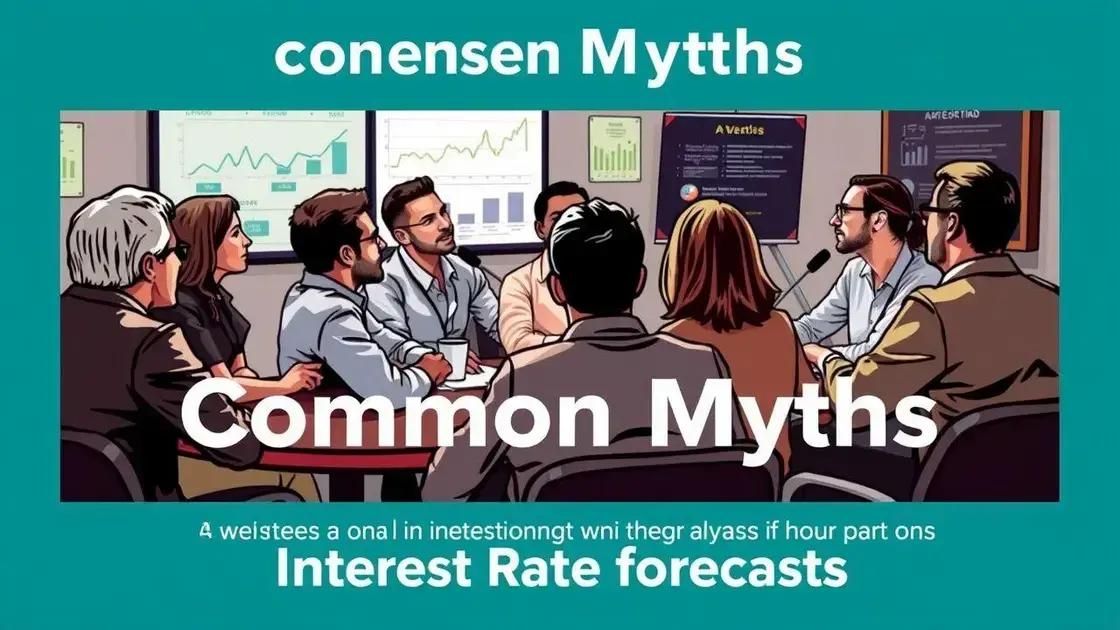Interest rate projections: What can we expect in 2024?

Interest rate projections significantly impact loan payments, savings growth, and overall financial planning, making it essential to monitor economic indicators and understand how these rates influence your finances.
Interest rate projections play a vital role in shaping our economic landscape. Have you ever wondered how these projections affect your savings or loans? Let’s dive deeper into the trends and insights.
Understanding interest rates and their significance
Understanding interest rates and their significance is crucial for anyone engaging with the economy. They impact a wide range of financial activities, from savings accounts to mortgages. Knowing how interest rates work can help you make informed decisions.
Interest rates determine the cost of borrowing money and the return on savings. When they rise, borrowing costs go up, and vice versa. This relationship affects both individuals and businesses. For instance, if you have a loan, a dip in interest rates could reduce your monthly payments.
The Impact of Interest Rates on the Economy
The overall economy responds to these changes. Lower interest rates encourage spending and investment, boosting economic growth. However, too low can lead to inflation. Here are some ways interest rates play a role:
- Influencing consumer spending
- Affecting business investment choices
- Shaping housing market trends
- Determining currency strength on the global market
Conversely, when interest rates increase, it can lead to reduced consumer spending. People may think twice before taking out loans for large purchases, like homes or cars. This slow down can affect job growth in various sectors.
Additionally, banks adjust their lending practices based on interest rates, which means fewer loans might be available. Understanding this cycle helps you navigate financial decisions more effectively.
Why Interest Rate Changes Matter
Being aware of interest rate changes can empower you to make smart financial decisions. For example, during low-rate periods, refinancing an existing loan may be beneficial. Additionally, keeping an eye on projected interest rate trends can prepare you for future changes in your payments.
As you grasp the significance of interest rates, you also foster better financial habits. This knowledge ensures you stay ahead of the economy’s ebb and flow. It can guide you in planning your investments, choosing loans, and managing your savings.
Factors influencing interest rate projections

Several factors influence interest rate projections, impacting both borrowers and savers. Understanding these factors can help you navigate your financial decisions effectively.
One major factor is inflation. When inflation rises, central banks often increase interest rates to maintain purchasing power. Higher rates can slow down borrowing and spending, which are crucial for economic growth.
The Role of Economic Growth
Economic growth also plays a vital role in shaping interest rates. If the economy is growing too quickly, it may lead to higher inflation, prompting central banks to raise rates. Conversely, a slowing economy might lead to lower rates to encourage borrowing and investment.
- Key indicators of economic growth include GDP and employment rates.
- Changes in consumer spending can also signal growth or decline.
- Expectations regarding future growth influence interest rates significantly.
Another factor is the monetary policy set by central banks. These institutions determine short-term interest rates, which influence borrowing costs. Their decisions can be based on economic data, making it essential to watch for announcements regarding rate changes.
Global events can also sway interest rates. For instance, geopolitical tensions or economic crises in other countries can lead to fluctuations in global markets, impacting domestic interest rates. Keeping an eye on international affairs is crucial for understanding potential changes in interest rate projections.
Market Sentiment
Market sentiment refers to how investors feel about the economy’s future. If investors are optimistic, demand for loans can increase, prompting higher interest rates. On the other hand, a wary market may lead to lower rates as banks compete for borrowers.
Staying informed about these factors can help you read the trends in interest rate projections. It allows you to make educated decisions, whether you’re looking to refinance a loan or invest in new opportunities.
Economic indicators to watch in 2024
Monitoring economic indicators is essential for understanding how interest rates might change in 2024. Several key indicators can provide valuable insights into the overall health of the economy and forecast potential interest rate adjustments.
One of the most important indicators is the Gross Domestic Product (GDP). GDP measures the total value of all goods and services produced in a country. A growing GDP typically indicates a healthy economy, which might lead to higher interest rates as demand for borrowing increases.
Employment Rates
The employment rate is another critical economic indicator. When employment is high, consumers have more disposable income, leading to increased spending. This can result in inflation, prompting central banks to raise interest rates to manage economic growth.
- Look for trends in job creation and the unemployment rate.
- Changes in wage growth can also signal shifts in the economy.
- Employment numbers released monthly can impact market expectations.
Inflation is a direct consideration as well. The Consumer Price Index (CPI) tracks price changes in consumer goods. If inflation rates rise significantly, it may compel central banks to increase interest rates. Consequently, monitoring CPI trends is crucial for anticipating rate changes.
Consumer Confidence Index
The Consumer Confidence Index (CCI) reflects how optimistic consumers feel about the economy’s future. A high CCI indicates consumers are likely to spend and invest, potentially prompting the need for higher interest rates. A falling CCI can lead to slower economic growth and lower rates as central banks respond accordingly.
Another vital aspect is manufacturing output. This indicator shows how much production is occurring in the manufacturing sector. Increased production usually means a growing economy, influencing interest rates positively. Likewise, a slowdown may lead to lower rates in response to decreased demand.
By paying attention to these economic indicators in 2024, individuals and investors can gain insights into potential interest rate movements. This knowledge can help in making informed financial decisions regarding loans, investments, and savings.
Common myths about interest rate forecasts

Many people hold misconceptions about interest rate forecasts that can lead to poor financial decisions. Clearing up these myths is vital for making informed choices about loans, investments, and savings.
One common myth is that interest rates will always rise during inflation. While it’s true that inflation often leads to higher rates, it is not guaranteed. Central banks may lower rates in certain situations to stimulate economic growth, even when inflation exists.
Interest Rate Forecasts are Always Accurate
Another misconception is that interest rate forecasts are always precise. In reality, they are based on economic models and can change due to unforeseen circumstances. Economic conditions can shift rapidly, making predictions challenging.
- Studies often use historical data to predict future trends.
- External events, like geopolitical tensions, can affect forecasts unexpectedly.
- Central bank decisions can lead to rapid changes in rate expectations.
Some believe that only financial experts can understand interest rates. However, anyone can grasp the basics of how rates work. Reading up on economic principles and monitoring current events can empower you to interpret forecasts better.
Interest Rates are the Same for Everyone
A widespread belief is that everyone pays the same interest rates. This is not true. Rates vary based on factors like credit scores, loan types, and lender policies. It’s crucial to shop around and understand your financial standing to get the best rates.
Lastly, many people think that fixed-rate loans are always better than variable-rate loans. While fixed rates offer stability, variable rates can be lower initially and may save you money over time. Evaluating your financial situation and risk tolerance is key to making this choice.
By addressing these common myths about interest rate forecasts, individuals can equip themselves with the knowledge needed for better financial planning. Understanding the nuances of interest rates leads to smarter decisions.
How interest rates affect your finances
Understanding how interest rates affect your finances is crucial for making informed decisions. These rates impact various aspects of your financial life, including loans, savings, and credit.
When interest rates rise, borrowing money becomes more expensive. This affects loans for homes, cars, and personal use. Higher interest means larger monthly payments, which can strain your budget. On the other hand, if rates fall, borrowing costs decrease, leading to lower payments and potentially freeing up cash for other expenses.
Impact on Savings Accounts
Interest rates also play a significant role in savings accounts. When rates are high, your savings earn more interest over time. This can lead to faster growth of your funds. Conversely, if rates are low, your savings grow more slowly, which can affect long-term financial goals.
- Consider how interest rates influence your savings strategy.
- Shop around for accounts that offer competitive rates.
- Track market trends to understand potential changes in your savings interest.
Another important aspect is credit cards. If you carry a balance, higher interest rates can lead to substantial debt. This makes it harder to pay off your balance, as more of your payment goes towards interest rather than the principal. Keeping credit card balances low is key to minimizing interest expenses.
The Bigger Picture
Interest rates also affect broader economic conditions, which in turn can influence your job security and income levels. In a high-rate environment, businesses may reduce spending, which can lead to layoffs or wage freezes. Monitoring interest rates can help you gauge economic health and adjust your financial plans accordingly.
In summary, staying aware of how interest rates influence your financial decisions will empower you to make smarter choices. Whether it’s deciding on loans, savings accounts, or credit usage, understanding this connection is essential for achieving your financial goals.
Tips for preparing for changing interest rates

Preparing for changing interest rates can help you manage your finances better. Being proactive allows you to adapt to shifts in the economic environment, minimizing negative impacts on your financial health.
One effective strategy is to monitor economic news regularly. Keeping an eye on reports about the economy, inflation, and central bank decisions can give you a heads-up about potential interest rate changes. You can find this information in financial news outlets or through economic forecasts.
Consider Fixed vs. Variable Rates
When securing a loan, think about whether a fixed or variable interest rate is best for you. A fixed rate offers stability, while a variable rate may start lower but could increase over time. Weigh the pros and cons based on your financial situation and goals.
- Fixed rates provide predictable payments.
- Variable rates can fluctuate based on market conditions.
- Consider your risk tolerance when making your choice.
Another tip is to pay down debt. High-interest debt, like credit card balances, can quickly become overwhelming if rates rise. Paying down these debts can free up money for other expenses and reduce financial stress.
Build an Emergency Fund
Creating an emergency fund is essential. Having savings set aside can provide a cushion during times of financial strain when interest rates may affect your budget. Aim to have at least three to six months’ worth of expenses saved up.
Additionally, diversify your investments. In a changing interest rate environment, certain asset classes may perform better than others. Consider spreading your investments across stocks, bonds, and other types of assets to balance the risks.
Lastly, revisit your budget. Keeping your spending plan updated helps you adjust quickly if interest rates change. Review your budget regularly to accommodate changes in payments, whether it’s for loans or savings.
By implementing these tips, you can better prepare for changing interest rates and maintain your financial stability. Staying informed and proactive is key to navigating the complexities of interest rate fluctuations.
In conclusion, understanding interest rates and how they affect your finances is essential for making smart financial decisions. By staying informed about economic indicators and being aware of common myths, you can harness this knowledge to manage your money effectively. Prepare for changing interest rates by monitoring the news, adjusting your budgets, and making strategic financial plans. Adopting these practices will help you maintain financial stability and thrive in varying economic conditions.
FAQ – Frequently Asked Questions about Interest Rates
How do interest rates affect loan payments?
Higher interest rates increase your monthly loan payments, making borrowing more expensive, while lower rates reduce those payments.
What should I do if interest rates rise?
Consider paying down high-interest debt, reassessing your budget, and monitoring economic news to prepare for changes.
How can I take advantage of low interest rates?
You can refinance loans to secure lower rates, invest in new opportunities, or increase savings in high-yield accounts.
Are there myths about interest rates I should be aware of?
Yes, common myths include the belief that interest rates will always rise during inflation and that forecasts are always accurate.






